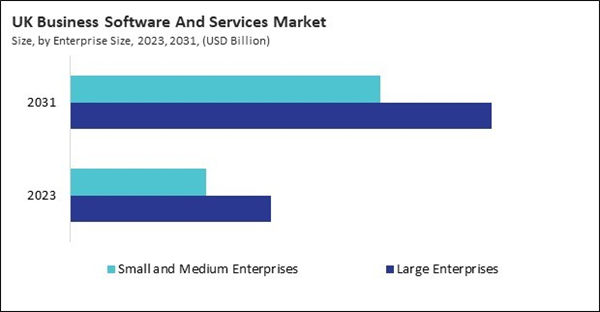The Germany market dominated the Europe Business Software And Services Market by country in 2023, and is expected to continue to be a dominant market till 2031; thereby, achieving a market value of $78.13 billion by 2031. The UK market is exhibiting a CAGR of 10.4% during 2024-2031. Additionally, the France market is expected to experience a CAGR of 12.3% during 2024-2031.
One of the key drivers of this market is the increased adoption of cloud computing. Companies no longer need to maintain expensive data centers as cloud service providers (CSPs) like Amazon Web Services (AWS), Microsoft Azure, and Google Cloud offer scalable, secure, and high-performance infrastructure. Moreover, the growing demand for automation and AI integration is revolutionizing businesses' operations.
Furthermore, the rise of big data and business intelligence (BI) tools is transforming how companies analyze and interpret vast amounts of information. Businesses utilize predictive analytics, data visualization, and AI-driven insights to optimize decision-making and improve operational efficiency. BI platforms such as Tableau, Power BI, and Google Data Studio allow organizations to process complex datasets and gain actionable insights in real-time.
The European market is expanding rapidly, driven by sector-specific advancements and government-backed digital initiatives. The European Commission’s Digital Decade Strategy aims to ensure that 75% of enterprises adopt cloud computing, big data, and AI by 2030, creating a fertile ground for software adoption. Additionally, investments in 5G, cybersecurity, and digital transformation programs accelerate software demand across industries. The United Kingdom’s transportation sector is undergoing a digital revolution, with increasing investments in smart mobility, logistics software, and intelligent transport systems (ITS). The UK government’s £90 million Future Transport Zones initiative aims to integrate business software solutions for public transport, fleet management, and logistics optimization. The rise of electric vehicles, connected transportation systems, and AI-powered route optimization software is further driving the need for cloud-based transportation management solutions to enhance operational efficiency and sustainability. Thus, these developments highlight a robust and diverse growth trajectory for the European business software and services market.
List of Key Companies Profiled
- Hewlett Packard Enterprise Company
- Microsoft Corporation
- Oracle Corporation
- IBM Corporation
- SAP SE
- Google LLC (Alphabet Inc.)
- Epicor Software Corporation
- ServiceNow, Inc.
- Salesforce, Inc.
- VMware, Inc. (Broadcom Inc.)
Market Report Segmentation
By Deployment
- Cloud
- On-premise
By Enterprise Size
- Large Enterprises
- Small and Medium Enterprises
By Service
- Managed Services
- Support & Maintenance
- Consulting
By Software
- Finance
- Sales & Marketing
- Human Resource
- Supply Chain
- Other Software
By End-use
- BFSI
- IT & Telecom
- Manufacturing
- Healthcare
- Retail
- Government
- Transportation
- Aerospace & Defense
- Other End-uses
By Country
- Germany
- UK
- France
- Russia
- Spain
- Italy
- Rest of Europe
Table of Contents
Companies Mentioned
- Hewlett Packard Enterprise Company
- Microsoft Corporation
- Oracle Corporation
- IBM Corporation
- SAP SE
- Google LLC (Alphabet Inc.)
- Epicor Software Corporation
- ServiceNow, Inc.
- Salesforce, Inc.
- VMware, Inc. (Broadcom Inc.)
Methodology

LOADING...









